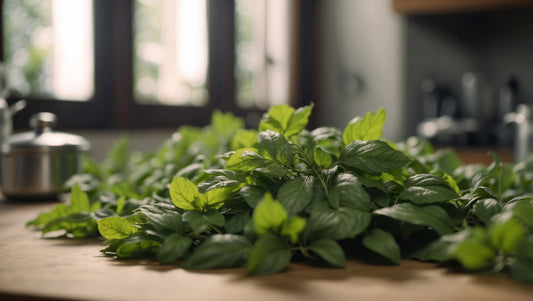By: Laurie Dohmen, VMD, MS, RH (AHG), FACVBM
I love adaptogens, they are my very favorite category of herbs. They are good for supporting the body, mentally and physically and, by definition, can do no harm. A brief definition of adaptogens is: “Adaptogens constitute a category of nutritional and herbal medicinal products essential for good health, adaptability, resilience, survival, and healthy aging. The key to understanding adaptogens is their role in establishing and maintaining adaptive homeostasis by building the body’s natural resistance to stressors, which may be physical, chemical, biological, and psychological in nature. Adaptogens function like stress vaccines to activate the body’s defense system and metabolic rate, reversing the negative physical effects of stress and restoring the body’s balance and health.” (1) Adaptogens support vitality, support the body throughout the lifespan, and generally make you feel better!
Ayurveda has another term for adaptogens, rasayana, which literally translates to “the path of juice” (2), because juice or ojas, is the milky white substance that provides nourishment to all the tissues in the body. So, herbs that are rasayana are revitalizing or rejuvenative and nourish all our tissues, including the brain.
One of my favorite adaptogens is Ashwagandha (Withania somnifera). It is a classic Ayurvedic herb, and the name means (depending on who translates it) either the “strength of a horse” or the “smell of a stallion.” It is indigenous to India and the surrounding area, and the root is the medicinal part. While in Ayurvedic medicine, ashwagandha is considered a male herb, it is equally usefully in males and females. (Shatavari [Asparagus racemosus] is the Ayurvedic female equivalent with the name meaning “100 husbands”.) It is very popular for sexual support, both for men and women, hence the name (same with shatavari). In India, ashwagandha is one of the most frequently used herbs, often in combination with other herbs. In my opinion, adaptogens such as ashwagandha are useful in every herbal formula for general support. In fact, on one occasion when I was lecturing on adaptogens, a veterinarian asked me “why everyone isn’t taking them all the time?” My answer: “I don’t know, I think they should be!”
In Ayurveda specifically, ashwagandha is found to be slightly sweet, as well as drying. It is a warming herb, so it is very nice in chai. It does decrease vata and kapha (more on doshas later!). It is quite palatable to animals, even cats. I learned it as the best adaptogen for older animals, but I have a colleague who works with a wildlife rehabber, and she swears by it for young, underweight animals. Ashwagandha is useful for support of all ages. Dr. Sodhi himself writes: “Over many years of observation, I have concluded that the full potential of Ashwagandha…has yet to be realized.” (3)
I use ashwagandha to support my patients in good health and poor health. In ruminants specifically, it supports lactation, which is nice for dairy cows and goats. (4) Because of the definition of how adaptogens or rasayanas work, most are mildly stimulating to the system. One of the things that makes ashwagandha unique among adaptogens is that it is relaxing. In fact, the Latin species name, somnifera, means sleep inducing. It is considered calming or grounding as well, which creates a nice balance between the stimulating effects common to rasayanas.
Ashwagandha is also used in the Middle East and Africa, as well as in the USA and Europe now that we have found it. Anyone who tries this herb realizes its potential for making the individual feel better (if not feeling their best) or great (if healthy).
While generally adaptogens are safe, caution should be used if considering ashwagandha with thyroid disease and pregnancy. Additionally, since ashwagandha is relaxing, it may enhance or over-do the effects of sedating medications. Lastly, ashwagandha is in the nightshade (Solanaceae) family, and some people (usually not so much our four-legged friends, but occasionally) are sensitive to this plant family.
As with all adaptogens, the effects of ashwagandha are slow to build, so it is an herb that needs to be taken for a minimum of 8 weeks. I have had patients be on formulas with ashwagandha for years at a time. I have used it to support animals with chronic conditions, with rescue animals to support their transition to pets, and with any animals that are getting older. I even recommend it to my human family members!
So, take it from either the Ayurvedic tradition or my student, rasayanas and other adaptogens like ashwagandha are a vital part of any formula to support health, whether the individual is burnt out or healthy!
References:
- Evolution of the Adaptogenic Concept from Traditional Use to Medical Systems: Pharmacology of Stress- and Aging-Related Diseases. Panossian, A, et al. 2020, Medicinal Research Reviews 41 (1), pp. 630-703.
- Khalsa, K. P. S. and Tierra, Michael. The Way of the Ayurvedic Herbs. Twin Lakes, WI : Lotus Press, 2011.
- Sodhi, Virender. Ayurvedic Herbs. Bothell, WA : Book Publishers Network, 2014.
- Williamson, E. Major Herbs of Ayurveda. Edinburgh : Churchill Livingstone, 2002.




